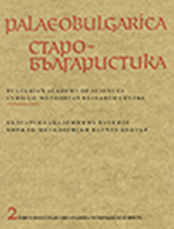Features of the Cynic-Stoic Diatribe in Early Slavic Homilies: Clement of Ohrid and His Literary Heritage
Features of the Cynic-Stoic Diatribe in Early Slavic Homilies: Clement of Ohrid and His Literary Heritage
Author(s): Simeon DekkerSubject(s): Language studies, Language and Literature Studies
Published by: Кирило-Методиевски научен център при Българска академия на науките
Keywords: Cynic-Stoic diatribe; Clement of Ohrid; Homilies; Polemics; parenthetical verbs.
Summary/Abstract: The Cynic-Stoic diatribe is a polemical-didactic mode of discourse organization, originating in Hellenistic Greek, in which a fictitious dialogue with an imagined interlocutor is dramatically performed. Previous research has established that the rhetorical and discourse-structuring features of the diatribe have exerted a considerable influence on Slavic homiletical works translated from Greek. Some indications for this influence have hitherto also been identified in non-translated Slavic writings. Clement of Ohrid is an important representative of early Slavic original authorship. It is, therefore, expedient to investigate his homiletical oeuvre and that of the ‘literary school’ over which he exerted his influence, to gauge the extent to which the diatribe gained ground in these non-translated works. Ten of the homilies ascribed to Clement or his ‘literary circle’ turned out to contain a sufficient number of features that can be interpreted as diatribal. This shows that the diatribal style had been appropriated and was implemented to a considerable degree already at an early stage of Slavic writing.
Journal: PALAEOBULGARICA / СТАРОБЪЛГАРИСТИКА
- Issue Year: 2022
- Issue No: 2
- Page Range: 97-120
- Page Count: 24
- Language: English
- Content File-PDF

